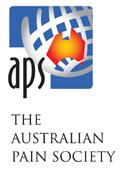Editor’s Note
Dr Lincoln Tracy
I’m writing this Editor’s Note in the middle of the IASP World Congress, which is currently being held in Toronto, Canada. Unfortunately, I was unable to attend in person. Instead, I’m staying up late and getting up early to watch sessions as part of the Virtual Program. It’s incredibly exciting to see multiple APS members make key contributions to the conference in terms of plenary or topical presentations, such as Professor Michael Nicholas, Professor Fiona Blyth, Professor Irina Vetter, and Emeritus Professor Maree Smith – showing how the APS punches above its weight when it comes to the world stage. I hope all APS members who were able to attend the World Congress in person had a fantastic time, especially those who were first time attendees! I still think fondly of the time I spent in Yokohama for the 2016 World Congress, which was my first.
But back on the home front, we have another bumper issue of the eNewsletter – this month things are really bursting at the seams. There’s plenty of information about the 2023 ASM in Canberra; make sure all the important dates are in your calendar or diary, so you don’t miss out on getting your abstract or Rising Star Award application in before the deadline(s).
We have four great journal watch submissions from the Pain in Childhood SIG, with all reviews provided by various members of the Children’s Pain Management Service at the Royal Children’s Hospital in Melbourne. Of particular interest was the review provided by Dr Emily de Jager, a psychologist, who discussed an article where a bus-related metaphor was used to help adolescents with chronic pain to identify barriers that they perceived were interfering with their ability to engage in age-appropriate materials.
This month we shine the member spotlight on Dr Kelsi Dodds, an early career postdoctoral researcher from Flinders University in Adelaide. Get to know Kelsi by reading through her profile and keep an eye out for her at future APS events – I benefited greatly from the warm and welcoming community when I joined the APS all those years ago.
Finally, Dr Aidan Cashin from the Centre for Pain IMPACT at Neuroscience Research Australia discusses how translational challenges can be addressed through partnering with people with lived experience of pain at all stages throughout the knowledge translation spectrum. I’ve seen first-hand the benefits of co-producing and co-designing research and clinical tools together with people with lived experience through the work of some of my colleagues at Monash University and The Alfred, and strongly recommend you consider how the knowledge gained from your research or clinical work could be better translated.
LincolnWHAT’S COMING UP?
We are excited to see you again at the APS 2023 Annual Scientific Meeting, and we are thrilled to host it in Canberra.

Here are a few things to look forward to in November!
Program Released
The full conference program will be released, including all the concurrent sessions and the full list of pre-conference workshops
Registrations Open: 15 November 2022
Registration information is now available on the conference website. Accommodation options are also available – now is the time to start planning your trip to Canberra next year
Complete the Expression of Interest form to be kept up to date with conference news as it becomes available
Should you have any queries about the conference, please contact the Conference Secretariat
IMPORTANT DATES FOR YOUR DIARY
Now Open!
Topical Session Submissions Open
Rising Star Award Applications Open
Free Paper/Poster Abstract Submissions Open
Tuesday 11 October 2022
Rising Star Award Applications Close Topical Session Submissions Close
Tuesday 25 October 2022
Free Paper/Poster Abstract Submissions Close
Tuesday 15 November 2022
Registrations Open!
SAVE THE DATE
APS 2023 will be held from 02 – 05 April 2023 at the National Convention Centre Canberra, ACT

Please visit the conference website here: www.dcconferences.com.au/aps2023
If you have any questions, please contact the APS Conference Secretariat: apsasm@dcconferences.com.au
TOPICAL SESSION SUBMISSIONS NOW OPEN!
Submissions Deadline: Tuesday 11 October 2022
On behalf of the Scientific Program Committee and the Local Organising Committee, we are pleased to advise topical session submissions for APS 2023 are now open.
The deadline for Topical Session submissions is:
Tuesday 11 October 2022
View the topical session submission guidelines.
The online topical session submission portal is now available via the conference website.
We look forward to receiving your submission. Should you have any queries regarding your submission or the process, please contact the Conference Secretariat.

ABSTRACT SUBMISSIONS NOW OPEN

Submissions closing: Tuesday 25 October 2022
Hurry! While abstract submissions are still open, the deadline for free paper and poster submissions is only a few weeks away.
Categories for Abstract Submission
• Experimental Studies (Clinical Studies, Basic Science, Public Health) and Clinical Trials
• Clinical Practice & Service Delivery (Poster Only)
• Case Reports (Poster Only)
Please note the following points regarding the submission process:
• If your abstract is accepted, either as a free paper or poster, there is an expectation that you will attend the conference to present this paper.
• Expressions of Interest (EOI) for travel grant applications are also being collected as part of the submission process.
• The submitting author MUST be the main author and the person who will present the work at the ASM. To view the abstract submission guidelines please click here.
We look forward to receiving your submissions. Should you have any queries regarding your submission or the process, please contact the Conference Secretariat
RISING STAR AWARD Now accepting applications!
Submission Deadline: Tuesday 11 October 2022

This award showcases rising star pain researchers in Australia and may be awarded annually subject to the application of suitable candidates. The Rising Star Winner will receive a return domestic airfare, accommodation, and complimentary registration to attend the 2023 APS 43rd ASM where they will give a plenary presentation to showcase their work and ideas.
Applications are now open, for further information and to apply, please click here.
Eligibility Criteria
• Nominees must hold a PhD and be within five (5) years of conferral by the deadline of this award application.
• Applicants can be working in any field of pain research, including basic science, biomedical, clinical, and other applied or cross-disciplinary sciences.
• The selection committee will consider personal or extenuating circumstances that might provide grounds for consideration if the above eligibility criteria are not met.
Please include details in the nomination form such as:
- Time out for maternity/parental leave/carer’s leave/ illness
- Significant breaks in research time (e.g., due to clinical work, reduced research-focussed post-doctoral employment)
- Pro rata (so relative to opportunity for those working as clinicians or teaching/research posts)
• Only individual scientists are eligible (not research teams)
• Applicants must be available to attend APS 2023, and to deliver the Rising Star presentation
• Applicants must be a member of the APS
• Applicants must be an Australian citizen/resident, currently working in Australia and have spent at least two post-doctoral years in Australia, or have returned to continue working in Australia
Selection Criteria
This award will be based on excellence in pain-related research achievement, demonstrated from the applicant’s track record, including:
• Specific research achievements or discoveries
• Research impact/application
• Collaboration achievements – independent of your supervisor
• Publication record (quality and impact of publications, e.g., H-index, standing of journals, citations)
• Grants obtained (as a Chief Investigator)
• Patents held
• Peer recognition: Awards or prizes, national profile, international profile.
For further information and to apply, please visit the Rising Star Application Guidelines.
We look forward to receiving your submission!
NOMINATION FOR AUSTRALIAN PAIN SOCIETY DISTINGUISHED MEMBER AWARD – 2023
The Board of Directors is seeking nominations from all Australian Pain Society (APS) members for candidates to be considered for the Distinguished Member Award(s) to be presented at the APS 43rd Annual Scientific Meeting to be held in Canberra from 2 - 5 April 2023.
Eligibility Criteria
• Candidates must be APS members who generally have had a lengthy career in the field of pain and have:
• Made major contribution1 towards the Society, and
• Significantly contributed to the science of pain management, and/or
• Played a significant clinical, educational or research role in the field of Pain Management in Australia.
1 Major contributions include, but are not limited to:
Scientific Program Committee involvement
– Pain research
– APS projects
– Subcommittee involvement
– Board liaison
Contributions to ASM presentations
Nomination Guidelines:
• A ‘Nomination for Distinguished Member Award’ form must be completed.
• As a guide, it is desirable that nominees have held continuous APS membership for over 10 years.
• Nominations must include an 800-900 word biography of the nominee. The Board will not consider incomplete nomination forms.
• Unsuccessful nominations are not automatically put forward in subsequent years.
• The nominator must be prepared to present a brief summary of the Distinguished Member biography in the ASM program, or arrange a suitable alternate for the presentation segment.
Submission
• All nominations to be submitted to the APS Secretariat by 31 October 2022.
Notification:
• The APS Board will notify successful nominees by 31 December 2022.

• Distinguished Member recipients are actively encouraged to attend the Annual Scientific Meeting in order to receive their award in person from the APS President.
The nomination form and a listing of past recipients of the Distinguished Member Award, including their biographies, can be found on the APS website.
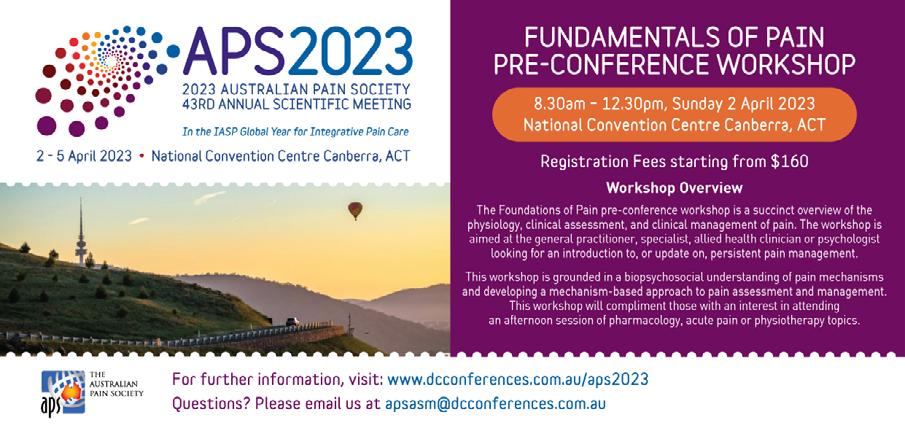
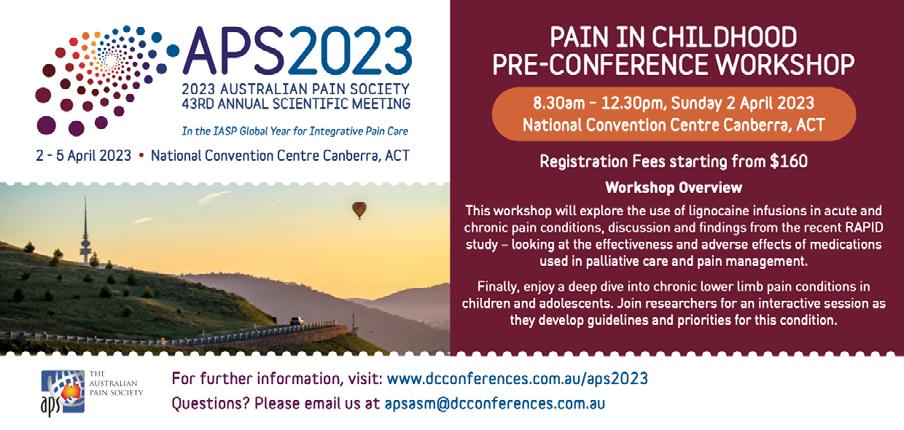
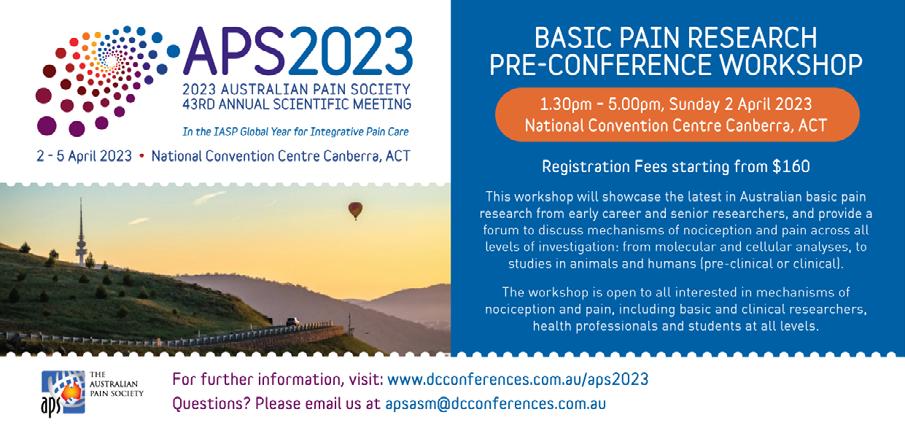
Annual Scientific Meeting Travel Grant Recipient Report
Tiffani MungovenTiffani is currently completing a PhD in episodic migraine under the supervision of Professor Luke Henderson in the Neural Imaging Laboratory at the Brain and Mind Centre, The University of Sydney. Tiffani is particularly interested in exploring structural and functional brain changes related to acute and chronic pain states and the associated underlying neural mechanisms and circuitry.
Author contact details: tmun8710@uni.sydney.edu.au
I had the privilege of being an APS travel grant recipient and I was very grateful to receive this grant as it was a significant help to assist me with attending the Annual Scientific Meeting in Tasmania. The grant greatly contributed to my attendance of the event by providing funds for transportation, administration tasks such as printing of materials, providing meals for the duration of the event, and various adhoc expenses. I chose to present a poster at this meeting to highlight my current migraine research in which the main finding was that altered anatomy in the trigeminal nerve is associated with altered brain anatomy, particularly in the midbrain periaqueductal grey matter in migraine participants. I believe my work was well received, as I was given positive feedback from numerous attendees about my research poster, which provided a great reference as to the trajectory of my work so far.
The meeting allowed me to meet many wonderful people with diverse backgrounds including academics and practitioners in the field who could be potential collaborators in the future. Overall, I had a really enjoyable experience interacting in elaborate scientific discussions with the attendees over the three days that the conference was held. Further, as much as I enjoyed exploring through and reading all the research posters that were displayed, the plenary sessions and discussion that followed was particularly interesting to listen to and was a highlight of the conference.
This was the first Australian Pain Society Meeting that I have attended in person due to limitations surrounding COVID-19 related arrangements resulting in the virtual delivery of the conference over the last few years, which also coincided with the beginning of my PhD. Despite the success of the virtual meetings, the opportunity to network in person during the meeting in Tasmania was invaluable and was unlike any other conference experience I have previously had. I am very pleased and grateful that I was able to attend this meeting before the completion of my PhD and the experience has left me with an appreciation of organising an event such as this with such a high standard, which has ultimately led to being my benchmark of all future conferences.
BLOG WEBWhat I am looking forward to most about coming back to the Annual Scientific Meeting next year is reconnecting with my fellow researchers and all the wonderful people that I met during the meeting in Tasmania. I am also very excited to present my future research and learn about all the novel pain research and progression of previous investigations. It is always interesting to hear about what is happening in the everevolving field of pain research, including insights into new therapeutics or clinical trials for the effective management of pain. Since the conference I am currently finishing my PhD thesis and have a paper pending for publication whilst also considering further research roles in academia.
Thank you again to the Australian Pain Society committee for this wonderful opportunity and experience.
Declaration:
Tiffani Mungoven has received funding from the Commonwealth Government for the Research Training Program (RTP) Stipend Scholarship and from The Australian Rotary Health for the Joan E Swanson PhD scholarship.

Annual Scientific Meeting Travel Grant Recipient Report
Tom Su
Tom is a neuroscience student in the first year of his PhD at UNSW. He is currently being supervised by A/Prof Gila Moalem-Taylor and Dr Felix Aplin to investigate the use of peripheral DC nerve block as a treatment for chronic pain.
Author contact details: tom.su@unsw.edu.au
APS 2022 – A novel experience for this 1st year PhD student
The Australian Pain Society 42nd Annual Scientific Meeting was the first conference I ever attended. In the weeks leading up to it, I was constantly looking forward to experiencing this format of event, as well as to meeting researchers with similar interests and hearing all about their projects. On top of that, I was scheduled to deliver both a 3-minute thesis and a free paper presentation, so there were definitely some nerves mixed in with excitement.
BLOG WEBThe first two days of the conference proper were like a whirlwind of new information. The three topical sessions I attended were themed around placebo/nocebo, osteoarthritis, and multiple sclerosis. All three of these sessions were fascinating, and I was very impressed by the quality of all the presentations I saw. On top of that were all of the amazing posters on display during lunch! Again, I was blown away by the variety of research topics being showcased (and I did enjoy the free lunches as well). On Tuesday afternoon I gave a free paper presentation in Session 6, which outlined our preliminary findings on the potential of charge-unbalanced electric currents in pain relief. In that session, though, I was particularly interested by Mr Michael Ferraro’s presentation on his meta-analysis of existing spinal cord stimulation treatments for chronic pain, which highlighted the necessity for more independent investigation into intervention efficacies in an industry largely funded by invested third-parties.
On Sunday, I attended the pre-conference workshop held by the Basic Pain Research Special Interest Group (BPR SIG). As someone whose time in research has been pretty short, I was quietly stunned by the breadth of research being presented, and the many approaches and techniques being used to investigate different aspects of pain. I particularly enjoyed the presentations by Drs Nathan Fiore and Lipin Loo, who talked about the roles of sexspecific microglia and RNA transcription in neuropathic pain, respectively. I also gave my three-minute thesis during this workshop, and won the competition (which I was definitely a bit surprised by, since I thought all of the entries were amazing!). In the evening we headed to Post Street Social for a SIG dinner, where I got to chat with lots of incredible people about their labs and their research interests, such as A/Prof Wendy Imlach at Monash, A/Prof Brett Graham at UON, and A/ Prof Peter Shortland at Western Sydney. A few of them even gave me really helpful advice to implement in my own project.
APS 2022 ended strong with a bevy of great plenary speakers on Wednesday. Of all the talks I heard during the conference, a strong contender for my personal favourite was A/ Prof Brett Graham’s, in which he discussed modern perspectives on spinal gating. It was very accessible but didn’t seem to compromise on accuracy, and his confidence in narrating a video playing behind him was a great touch.
From the diverse range of speakers and topics to the fun after-hours activities, tasty nibbles, and beautiful Hobart harbour, APS 2022 really delivered as my first ever conference and left me keen for more. I’m very grateful to the APS, whose travel grant helped enable me to attend, and I’m looking forward to seeing everyone at APS 2023!
Declaration:
Tom Su has nothing to declare.
Paediatric chronic pain prevalence in low- and middle-income countries: A systematic review and meta-analysis
Journal Reference: ZW Liao, C Le, JM Kynes, JA Niconchuk, E Pinto, HE Laferriere. Lancet eClinical Medicine 2022;45:101296
DOI: https://doi.org/10.1016/j.eclinm.2022.101296
Reviewer: Louise Jeynes, Pain Fellow, Children’s Pain Management Service, Department of Anaesthesia and Pain Management, Royal Children’s Hospital, Melbourne
Review of Article
All the studies from low- and middle-income countries (LMIC) that were published up to the 7 January 2022 in those 19 years or younger with chronic pain defined as per ICD-11 coding (i.e., lasting three or more months in duration).
Aims
The aim of the study was to characterise the current literature on the prevalence of paediatric chronic pain in low- and middleincome countries.
Method
The reviewers undertook a systematic review and meta-analysis search using four conceptual blocks: pain, paediatric, geographical, and epidemiological. A LMIC was defined as a country with gross national income per capita of less than $12,535 in 2019. All languages were included, with translation using Google Translate as necessary. The data was extracted by two independent reviewers, and statistical methods (general linear mixed model with logit transformation and random effects model) were selected to attempt to control for heterogeneity. Subgroup analysis was undertaken by sex, and odds ratio was undertaken for pain type. A risk of bias assessment and sensitivity analysis were also undertaken.
Results
Of the 2877 articles identified, 27 studies where suitable for review. There were 24 cross sectional studies, two prospective studies,
and one retrospective study. Study size varied from 209 – 92,544 with an absolute mean of 5094, and a trimmed mean (excluding uppermost and lowest value) of 1792.
These studies covered 20 LMICs from six regions, with only one being a multicountry study covering seven LMICs, from which data was extracted separately. Most studies focused on headache, followed by musculoskeletal pain, abdominal pain, generalised/fibromyalgia pain, and temporomandibular joint (TMJ) pain.
The studies identified an overall prevalence of paediatric chronic pain of 8% (95% confidence interval [CI] 6-10%). With respect to specific conditions, general/multi-site pain had a prevalence of 20% (95% CI 16-25%), musculoskeletal/back pain 9% (95% CI 7-13%), abdominal pain 7% (95% CI 5-10)%, headache 4% (95% CI 2-10%), fibromyalgia 3% (95% CI 1-10%), and TMJ dysfunction prevalence of 15% (but this was a single study). A higher prevalence was noted in females for chronic headache, abdominal, and general/multi-site pain. The prevalence of musculoskeletal pain was similar between sexes.
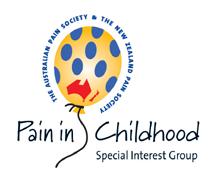
Conclusions
The data collected in this meta-analysis is comparable to that of the Global Burden of Disease 2013 (1) study on children and adolescents: the larger range in the prevalence seen in the previous study may be secondary to a less specific chronicity of pain. The prevalence of recurrent abdominal pain seen in LMIC children appears to be comparable to those from high income countries (HIC). The prevalence of fibromyalgia, whilst it is half that of the adult population from LMIC, it is comparable to that seen in children from HIC. Generalised pain (excluding fibromyalgia diagnosis) is higher in children from LMIC compared to adults (12% vs 20%).
The reviewers outlined some of the limitations of the study in terms of:
1. Geography: only 9% of the studies come from Sub-Saharan Africa and none from Central America
2. Definition: the ICD-11 definition of chronic pain is only recent, therefore studies prior to when this definition came in have differing reference ranges
3. Bias: risk of recall bias due to the selfreported nature of pain.
Reviewer’s critique & take-home messages
This article gives an insight into the prevalence of pain in LMIC and is the first meta-analysis of the data. There were no randomized controlled trials included in the meta-analysis; most were cross-sectional studies of reasonable sized populations, allowing for conclusions to be drawn. An increased prevalence of various chronic pain conditions has previously been reported in HIC in girls, in older children, and in those of lower socioeconomic status (2). Headache and musculoskeletal/back pain appear to be less prevalent in the LMIC population compared to the HIC population, while abdominal pain seems to have a similar prevalence. Generalised or widespread pain appears to be more prevalent in LMIC. There is significant variation in the rates of different disease processes globally with, LMIC seeing higher rates of certain multi-system disorders (e.g., sickle cell, HIV/AIDS, etc.). Cultural differences need to be considered in both the significance and the reporting of pain: are we using the correct scoring systems or measures and therefore comparing like with like?
BLOG WEB
for the study may not reflect the whole population, which can further under-estimate the prevalence.
What this study does bring is a demonstration that more work needs to be done in this area to support policy makers, to guide training provision in the different areas and the allocation of resources. A consistent definition of chronic pain is essential going forward ensuring more meaningful comparative data and therefore more useful results.
Declaration
The author has no conflict of interest to declare in reviewing this article.
References
1. Global Burden of Disease Pediatrics Collaboration, Kyu HH, Pinho C, Wagner JA, et al. Global and National Burden of Diseases and Injuries Among Children and Adolescents Between 1990 and 2013: Findings From the Global Burden of Disease 2013 Study. JAMA Pediatr. 2016 Mar;170(3):267-87. doi: 10.1001/ jamapediatrics.2015.4276. PMID: 26810619; PMCID: PMC5076765.
2. King S, Chambers CT, Huguet A, et al. The epidemiology of chronic pain in children and adolescents revisited: a systematic review. Pain. 2011 Dec;152(12):2729-2738. doi: 10.1016/j.pain.2011.07.016. PMID: 22078064
The reviewers recognise the limitations of their study (i.e., significant heterogeneity of the included studies) and had put interventions in place to moderate this. However, there is a risk of complex statistical analysis over-damping the numbers through trying to compensate for this heterogeneity. There is also a possibility of increased publication bias in LMIC due to more limited resources in these regions. Access to health care in some of these countries is very variable, and so those presenting themselves
Impaired School Functioning in Children with Chronic Pain: A National Perspective
Journal Reference: Groenewald CB, Tham W, & Palmero TM. Impaired School Functioning in Children With Chronic Pain: A National Perspective. Clinical Journal of Pain 2020;36(9):693-699.

DOI: 10.1097/AJP.0000000000000850
Reviewer: Monica Malhotra, Senior Occupational Therapist, Children’s Pain Management Service, Department of Anaesthesia and Pain Management, Royal Children’s Hospital, Melbourne
Aims
The purpose of this study was to determine the association between presence of chronic pain and school functioning among school aged children (6-17 years) using the most recent United States national data. The study also aimed to report associations between chronic pain and multiple aspects of school functioning, including (1) child school engagement, (2) chronic absenteeism, (3) child having problems at school, (4) repeating a grade, and (5) being diagnosed with a learning disability. Exploration of whether school functioning and chronic pain differed by age and sex was also a key aim of the study.
Method
A secondary analysis of data from the 2016-2017 National Survey of Children’s Health (NSCH) was used. The NSCH is an annual cross-sectional survey, conducted via in-person interviews of randomly sampled households, selected via a multistage process to represent the entire civilian, non-institutionalized population of the United States. The primary purpose of NSCH is to provide national estimates of the health status of the United States childhood population.
For each family included in the NSCH, 1 child (17 years or younger) was selected to be the subject of the survey, while 1 parent responded to questionnaires. Parents responded to
whether their child had chronic pain over the past 12 months though a questionnaire. They also reported on school functioning in terms of engagement with school, school absenteeism, problems at school, repeating a grade, and diagnosis of a learning disability.
Children with chronic pain were compared with children without chronic pain using multivariate logistic regression models. Analysis was also stratified according to age and sex. Other covariates included, child race/ethnicity, household income, insurance status, census region, parent education. Previous studies proved depressive and anxiety symptoms are directly related to school functioning children with chronic pain, and for this reason, these two variables were included in multivariate analysis.
Results
Eight percent of 48,254 parents reported their child having chronic pain in the last 12 months. Chronic pain was more common among 15-17-year-olds (as compared with younger age groups), females compared to males, and in children from lower household income levels. Race, ethnicity, and census region were not associated with chronic pain status. Chronic pain was more common among children with anxiety and depression.
Multivariate analyses revealed children with chronic pain had a nearly 90% increased odds of school reported problems, a 60% increased likelihood of having a learning disability, a 40% increased likelihood of poor school engagement and a 40% likelihood of repeating a grade at school. Anxiety was significantly associated with all school measures, while depression was associated with poor school engagement, chronic absenteeism, and school related problems.
Conclusions
The study provides further evidence that children with chronic pain had significantly
worse school functioning compared with children without chronic pain, in a large, national sample. It highlights the need for continued collaborative care especially for vulnerable populations.
Reviewer’s critique & take home messages
Overall, this research article provides informative data and findings on the association between chronic pain and school functioning, using a large, national sample. Cross-sectional design can, at times, provide inaccurate and less specific data, and doesn’t allow for a casual relationship between chronic pain and school functioning to be established. It was not clear how much information was provided to the parent on what constitutes chronic pain or what symptoms to look out for to identify if their child had experienced chronic pain in the last 12 months. This could have led to under- or over-reporting, bias on answers provided, and somewhat skewed the data, given it relied on parent memory over the past 12 months. The article also acknowledges these limitations of the study.
The writer found it helpful in understanding the multivariate factors impacting chronic pain and school functioning, particularly the references to previous studies on the link
between anxiety, and depression. For most clinicians working in paediatric chronic pain, it is unfortunately a common occurrence for children to present with comorbidities, and having further evidence to link between anxiety, depression, chronic pain, and school functioning, highlight the importance of utilising a multidisciplinary and collaborative approach.
This study paves the path forward for further research and investigation into the links between chronic pain and school functioning for children and adolescents, which is more than important given school is the primary occupation for most young people. The impact of loss of school functioning linked to chronic pain outcomes, may perpetuate the chronic pain cycle, and lead to poorer social determinants of health.
Ultimately, the writer finds this study to be inspiring, and agrees that chronic pain and school functioning is an area that needs to be addressed, not only at an individual level, but also by implementing population-based approaches within the wider community.
Declaration
The writer has no conflict of interest to declare in reviewing this article.
Which passengers are on your bus? A taxonomy of the barriers adolescents with chronic pain face in achieving functional recovery
Journal Reference: Jacobs K, Smith A, Heathcote L, & Caes L (2020). Which passengers are on your bus? A taxonomy of the barriers adolescents with chronic pain face in achieving functional recovery. European Journal of Pain, 25(1), 348-358.
DOI: 10.1002/ejp.1673
Reviewer: Dr Emily de Jager, Psychologist, Children’s Chronic Pain Management Service, Department of Anesthesia, Royal Children’s Hospital
Review of article
Participants were 41 adolescents aged 10-19 years (80% female) attending clinical psychology assessments as part of their intensive interdisciplinary pain treatment (IIPT) at the Oxford Centre for Children and Young People in Pain, in Oxford, UK. Participants reported a wide range of chronic pain symptoms including widespread musculoskeletal pain, localized musculoskeletal pain, complex regional pain syndrome and abdominal pain. The study used retrospective analysis of collected data, thus participants were unaware of the study when providing the clinical data.

Aims
The aim of the study was to gain a comprehensive insight into adolescents’ perceptions of the barriers they need to overcome to engage with age-appropriate activities to achieve functional recovery (e.g., full school engagement, engagement in sports, social engagement).
Method
Participants completed the ‘passenger on the bus metaphor’ exercise in their first session of a two- or three-week IIPT program. In this exercise, participants identify and describe their individual perceived barriers (discussed as ‘passengers’ on their bus) that prevent them from engaging in age-appropriate functional
activities. The metaphor asks the participants to imagine that they are driving a bus towards their valued direction, the passengers on the bus represent hindrances or the participants thoughts and feelings that make it more difficult or prevents them from reaching their valued direction. The metaphor was introduced by the psychologist and a worked example was provided, before the psychologist then walked the participant through the steps to apply the metaphor to their own experience and identify their own barriers to engagement. Although this was done in the first session of an IIPT, the psychologist had several previous sessions with the participants to build rapport.
Results
The researchers applied a retrospective analysis of the clinical data. Qualitative methods were used and found seven domains representing different barriers adolescents with chronic pain face to engage with daily age-appropriate activities. The domains were: ‘Physical constraints’, ‘Being fed up’, ‘Low self-confidence/self-esteem’, ‘Perfectionism’, ‘Avoidance of engagement with pain’, ‘Social barriers’, and ‘Feelings’. There were four subdomains within ‘Feelings’: ‘Sadness’, ‘Anger and frustration’, ‘Guilt’, and ‘Anxiety’.
Conclusions
The findings show a variety of perceived barriers which interfered with engagement in age-appropriate activities and progress within IIPT. The ‘Passenger on the bus’ metaphor appeared to be an effective way to engage adolescents in a sensitive conversation regarding the barriers they experience. Awareness of these barriers may help therapists working in a IIPT to individualise treatment approaches accordingly.
Reviewer’s critique & take-home messages
The authors provided an interesting discussion relating their findings to both the
Interpersonal Fear Avoidance Model and the Children’s Health Belief Model, providing a logical rationale for how the current findings aligned with both models. It would be interesting to consider whether the patient’s stage of change (or other psychological constructs, such as locus of control) may have played a role in the types of barriers they perceived.
Additionally, there seemed to be a large range of specific, individual barriers under each of the barrier domains, particularly ‘social barriers’. Assessment of the individual and their specific barriers is still needed but this gives a nice framework for clinicians to think about the different domains of barriers and types of questions to be asking patients.
The authors considered some of the limitations to the study including how the biases of the single psychologist who assessed all patients may have affected the results. I also wonder how generalizable the results would be to an outpatient service where the
patients are not receiving quite the intensive treatment of an inpatient stay and whether there would be different barriers that affected outpatients, given they are returning to family and school environments.
This study demonstrates an interesting, novel way of exploring perceived barriers to treatment for adolescents engaging in an intensive interdisciplinary pain management program. This is an important topic, given how commonly it is reported in the literature and anecdotally. Understanding these barriers and having a framework or guideline to better help clinicians to assess these barriers will hopefully help to build rapport and trust and allow a more individualized treatment approach, hopefully improving engagement.
Declaration
There are no conflicts of interest to declare in reviewing this article.
Prevalence and associated psychosocial and health factors of chronic pain in adolescents: Differences by sex and age
Journal Reference: Wager J, Brown D, Kupitz A, Rosenthal N, and Zernikov B. Prevalence and associated psychosocial and health factors of chronic pain in adolescents: Differences by sex and age. European Journal of Pain. 2020;24;761-772.
DOI: https://doi.org/10.1002/ejp.1526
Reviewer: Greg Evans, Physiotherapist, Children’s Pain Management Service, Department of Anaesthesia and Pain Management, Royal Children’s Hospital, Melbourne
Review of article
Data was collected from 2,208 adolescent participants aged 10–18 years from five schools in Germany. Within this group of participants, 52% were female. The mean age was 12.95 years.
Aims
Wager et al. aimed to quantify the prevalence of chronic pain among adolescent school students and determine how chronic pain prevalence differs between girls and boys of different ages. An additional aim of this cross-sectional study was to determine the psychosocial and health factors associated with an adolescent’s risk of having or developing chronic pain and determine which of these factors were more prominent in each age group and between the two sexes.
Method
Data was collected across five schools in Germany as part of the CHAP (“Chronic headache in adolescents: the patient perspective on health care utilization”) study. Cross sectional data was then extrapolated to form the data subset for this article utilizing a cross-sectional observational design.
Students completed an electronic survey during school hours. The survey addressed several different subsections, including demographic factors (age, sex, socioeconomic status [SES],
migration background), pain characteristics (location, frequency, duration, intensity, chronic pain, pain related school absence), psychological factors (depression and anxiety), school factors (school satisfaction and perceived school performance), and health behaviour factors (sleep issues and physical activity).
The study also mentions a parental survey. However, no further information on the nature or delivery of this survey is provided.
Results
One third of the sample (33.6%; n=765) reported chronic pain, characterized as weekly pain experienced for a period of greater than three months. The three most common locations of pain were the head (21.4%), musculoskeletal system (15.7%) and abdomen (10.7%).
Females had a 29% increased probability of having chronic pain (compared to 16% in males) per additional year of age. The SES was only significant for boys aged 10-13 years, with higher socioeconomic status correlating with increase chronic pain in this subgroup. Individuals with depression and anxiety were 105% and 51%, respectively, more likely to experience chronic pain. School satisfaction showed significant association with pain however, perceived school performance did not meet statistical significance overall. Poor sleep was associated with a 234% increased risk of experiencing chronic pain and significant across all age and sex subgroups. The number of times an individual completed the recommended physical activity per week was not statistically significant towards their risk of experiencing chronic pain.

Conclusions
Psychological factors and poor sleep demonstrate significant risk factors for the potential of an adolescent to experience chronic pain, which is supported by multiple research articles.
However, statistically significant differences in additional risk factors can be observed when specific subgroups of adolescents are analysed separately, including school satisfaction and perceived school performance.
Reviewer’s critique & take-home messages
There is limited research assessing the age and sex related differences in risk factors associated with chronic pain. While the relatively large sample size provides confidence in the findings, the cross-sectional design of this study means that causal inference cannot be made. The reviewer agrees with the author’s discussion that further age and sex related research data is necessary (including prospective studies) to determine age and sex specific factors contributing to prevalence of chronic pain and clarify the cause-and-effect relationship.
The multitude of psychosocial and health related factors that contribute to an individual’s overall potential to experience chronic pain, or their perpetuation of the cycle of chronic pain, are varied and complex. This, and other articles help to shed light on some of the patterns within the presentation of chronic pain to help guide therapy interventions as well as shape the potential for widespread, multimedia, preventative health promotional measures.
As clinicians within the space of paediatric/ adolescent chronic pain it is important to always work within a family-centred care model of practice and consider the wide variety factors that contribute to the pain experience of our individual patients.
Declaration
The author has no conflict of interest to declare in reviewing this article.
Communicating with children about ‘everyday’ pain and injury: A Delphi survey
Thank you to APS members Sarah Wallwork, Lorimer Moseley AO, and their colleague Melanie Noel for sharing the following recent publication.
Article first published online: July 13, 2022
Journal Reference: PAIN: Wallwork SB, Noel M, Moseley GL. Communicating with children about ‘everyday’ pain and injury: A Delphi study. Eur J Pain. 2022 Jul 13. doi: 10.1002/ ejp.2008. Epub ahead of print. PMID: 35829711.
DOI: https://doi.org/10.1002/ejp.2008
Abstract
Background
‘Everyday’ pain experiences are potentially critical in shaping our beliefs and behaviours around injury and pain. Influenced by social, cultural, and environmental contexts, they form the foundation of one’s understanding of pain and injury that is taken into adulthood. How to best communicate to young children about their everyday pain experiences, in order to foster adaptive beliefs and behaviours, is unknown.
Methods
In this Delphi survey, we sought expert opinion on the key messages and strategies that parents/caregivers can consider when communicating with young children (aged 2-7 years) about ‘everyday’ pain that is most likely to promote recovery, resilience and adaptive pain behaviours. Eighteen experts participated including specialists in paediatric pain, trauma, child development, and psychology; educators and parents. The survey included three rounds.
Results
Response rate was over 88%. Two hundred fifty-three items were raised; 187 reached ‘consensus’ (≥80% agreement among experts). Key messages that the experts agreed to be ‘very important’ were aligned with current evidence-based understandings of pain and
injury. Strategies to communicate messages included parent/caregiver role-modelling, responses to child pain, and discussion during and/or after a painful experience. Other key themes included promoting emotional development, empowering children to use active coping strategies, and resilience building.
Conclusions
This diverse set of childhood, pain and parenting experts reached consensus on 187 items, yielding 12 key themes to consider when using everyday pain experiences to promote adaptive pain beliefs and behaviours in young children.
Implications/Discussion
BLOG WEB
Parents and caregivers likely play a critical role in the development of children’s fundamental beliefs and behaviours surrounding pain and injury that are carried into adulthood. Everyday pain experiences provide key opportunities to promote positive pain-related beliefs and behaviours. This Delphi survey identified key messages and strategies that caregivers can consider to optimise learning, encourage the development of adaptive pain behaviours, and build resilience for future pain experiences.
Declaration
GLM has received support from: Reality Health, ConnectHealth UK, Kaiser Permanente, AIA Australia, Workers’ Compensation Boards, and professional sporting organizations in Australia, Europe, and South and North America. Professional and scientific bodies have reimbursed him for travel costs related to presentation of research on pain at scientific conferences/symposia. He has received speaker fees for lectures on pain and rehabilitation. He receives royalties for books on pain and pain education. SBW and MN have no conflicts of interest.
SBW and GLM have received funding from NHMRC Leadership Investigator Grant awarded to GL Moseley ID1178444.
Thank you to APS members Edel O’Hagan, Adrian Traeger, Benedict Wand, Aidan Cashin, and James McAuley as well as their colleagues Siobhan Schabrun, Sean O’Neill, and Ian Harris for sharing the following recent publication.
Article first published online: 15 July 2022
Journal Reference: O’Hagan E, Traeger AC, Schabrun SM, O’Neill S, Wand BM, Cashin A, Williams CM, Harris IA, & McAuley JH. It’s safe to move! A protocol for a randomised controlled trial investigating the effect of a video designed to increase people’s confidence becoming more active despite back pain. BMJ Open 2022;12:e063250.
DOI: 10.1136/bmjopen-2022-063250
Abstract
Introduction
BLOG WEB
Social media provides promising contemporary platforms for sharing public health information with a broad audience. Recent research suggests that people with low back pain value learning about causes of low back pain, and people with low back pain who accept evidence-based messages, such as pain does not equal damage, are likely to intend to selfmanage their low back pain. Yet, inaccurate information is common in community healthcare settings and on health websites. Challenging unhelpful beliefs about low back pain was identified as one of the top 10 priorities for researchers, considered vital to reverse the alarming global rise in low back pain disability and healthcare costs.
One approach that has been successful at decreasing low back pain-related costs on a large scale are mass media campaigns that deliver a public health message to a broad audience. Before implementation, testing media campaigns that are intended to engage audiences and initiate behaviour change is necessary.
Objective
This trial aims to investigate the effectiveness of a public health campaign on social media at increasing people’s confidence becoming more active despite low back pain in comparison with no intervention.
Trial design
This trial is a three-group, parallel, randomised controlled trial (RCT) with two intervention groups and one control group in a 1:1:1 allocation.
Methods and analysis
People over 18 years of age and fluent in English will be recruited via social media advertising. Both video interventions follow the same narrative that scientists would like to reassure the public that low back pain is common, and that evidence suggests it is safe to move despite back pain
The featured scientists report that they are unsure of how to convey these messages to the public, which leads to designers at an advertising agency brainstorming how to help deliver the key message that it is safe to move. The advertising agency personnel suggest a dance. The video cuts back to the scientists who are reluctant to endorse one specific movement, such as a dance and conclude that it does not matter what you do as long as you move. The video ends with the superimposed text, ‘It’s safe to move’, ‘Your backbone has backbone’. The second video is the same as the first, except that when the advertising agency suggests the dance, the scientists try it out and to add humour, there are some video clips of the scientists dancing.
Participants in the control group will not view either video intervention.
The primary outcome will be item 10 of the Pain Self-Efficacy Questionnaire, which asks participants to rate how confident they
It’s safe to move! A protocol for a randomised controlled trial investigating the effect of a video designed to increase people’s confidence becoming more active despite back pain
would feel to gradually become more active despite pain. This outcome will be measured immediately in all participant groups. We will compare group mean of the three arms of the trial using univariate analyses of variance.
The secondary outcome will be Factor 1 of the AxEL-Q Questionnaire. The AxEL-Q is a questionnaire designed to assess attitudes toward education and advice for low back pain. We will conduct a qualitative evaluation to understand the helpfulness, engagement and the experience of watching the video.
Patient and public involvement
Consumers with low back pain were consulted throughout the design of the intervention
process. Each major milestone of the intervention development was reviewed by members of the Musculoskeletal Health Consumer Community Council for Maridulu Budyari Gumal before proceeding to the next stage. The consumer group provided suggestions which were implemented in the revised versions including changes to the language used and written text superimposed in both videos.
This is a protocol; results are not available as yet.
Declaration
This project was funded by Maridulu Budyari Gumal. Edel O’Hagan has nothing to declare.
Have you had an article accepted for publication recently?
The Australian Pain Society (APS) is keen to share publications from our members with their colleagues via our eNewsletter. If you’ve had an article accepted or published recently, please contact our Assistant Editor Joanne Harmon via the APS Secretariat (aps@apsoc.org.au) with the title, authors, and reference (i.e., journal, volume, and DOI) of your article and request the submission template. We would love it if you also supply a short commentary (300 words max) to give our readers the gist of the article.
Thank you to APS members Damien Boorman and Kevin Keay for sharing the following recent publication.
Article first published online: 19 July 2022
Journal Reference: Boorman DC & Keay KA (2022) Sex differences in morphine sensitivity are associated with differential glial expression in the brainstem of rats with neuropathic pain. Journal of Neuroscience Research, 00, 1– 18.
DOI: 10.1002/jnr.25103
Abstract
Introduction
Chronic pain is more prevalent and reported to be more severe in women. Opioid analgesics are less effective in women and result in stronger nauseant effects. The neurobiological mechanisms underlying these sex differences have yet to be clearly defined, though recent research has suggested neuronal–glial interactions are likely involved. We have previously shown that similar to people, morphine is less effective at reducing pain behaviors in female rats.
BLOG WEB
including the rostral ventromedial medulla (RVM), the subnucleus reticularis dorsalis (SRD), the gracile nuclei, and the area postrema.
Results
Morphine administration had small sexdependent effects on overall GFAP expression, but not on astrocyte morphology, in the RVM, the SRD, and the area postrema. Significant sex differences in the density and morphology of GFAP immunopositive astrocytes were detected in all regions of interest. In general, GFAPpositive cells in females showed smaller volumes and reduced complexity than those observed in males. Furthermore, females showed lower overall GFAP expression in all regions except for the area postrema, the critical medullary region responsible for opioid-induced nausea and emesis.
Conclusions
These data support the possibility that differences in astrocyte activity might underlie the sex differences seen in the processing of opioids in the context of chronic neuropathic pain.
Implications/Discussion
Methods
This study investigates the expression of astrocytes in brainstem regions involved in the modulation of pain and the processing of opioids in female and male rats with neuropathic injury. We used the immunohistochemical detection of glial fibrillary acidic protein (GFAP) expression to investigate sex differences in astrocyte density and morphology in several medullary regions
These data implicate differences in astrocyte activity as a contributing factor in the commonly observed sex differences in the analgesic and emetic effects of opioids seen in both clinical and preclinical studies.
Declaration
Damien Boorman and Kevin Keay have nothing to declare.
Sex differences in morphine sensitivity are associated with differential glial expression in the brainstem of rats with neuropathic pain
Meet a Member
Dr Kelsi Dodds, PhDDr Kelsi Dodds is currently an early career postdoctoral researcher from the College of Medicine and Public Health at Flinders University in Adelaide (Kaurna Country), South Australia. She is a new APS member, having joined earlier in 2022.
How did you get into pain research/clinician practice?
My pain research journey started in 2014 when I was recruited by Professor Mark Hutchinson to undertake a PhD at the University of Adelaide. Together with my co-supervisors, Associate Professor Susan Evans and Associated Professor Elizabeth Beckett, my project investigated a role for spinal glial cells in the development of endometriosis and associated pelvic pain.
What does your current research or clinical practice focus on? Why is this important?
During my PhD, I was fortunate to interact with pelvic pain patients through Associate Professor Evans’ clinic, hearing of the daily burden their conditions (e.g., endometriosis, period pain) had on their lives. For many girls, women, and people assigned female at birth, available medical management options for pelvic pain were (and still are) largely invasive and/or ineffective. Considering this major need, I returned to foundational research to study how the sensory pathways of pelvic organs (including the uterus and gut) work under normal conditions. In my current postdoctoral position with Professor Nick Spencer at Flinders University, I utilise a range of cutting-edge research tools (e.g., genetically engineered mice, optogenetics, and novel surgical techniques) to uncover the fundamental information that may help to develop innovative treatments for pelvic pain.
What do you think will be the next “hot topic” in your area of research or practice?
Intersectional genetics is a highly sophisticated and rapidly expanding experimental technique in
the neurosciences. By injecting designer viruses into genetically engineered mice, researchers can visualise, activate, and/or ablate specific nerve pathways between two organs of interest. This technique seems ideal for studying pelvic organ cross sensitisation – the phenomenon where a problem causing pain in one pelvic organ can lead to pain from adjacent (otherwise healthy) pelvic organ. Aside from my own work (of course!), I think this could be the next ‘big thing’ in pelvic pain research.
If you could offer one piece of advice to a younger you, what would it be and why?
One of the key life lessons I have come to terms with over the past few years is to not be afraid to ask for help – as the old proverb goes: a problem shared is a problem halved. Being a perfectionist at heart has meant that I have always strived to be self-sufficient and complete any task to a high standard (through my eyes). I thought that asking for help exposed me as being incompetent and therefore imperfect. Now, I recognise how unsustainable that mentality can be – for both my health and productivity. I still try to problem solve as best I can but do not dwell on problems for too long before seeking support. I have come to realise that most people want to help, and that being self-aware of your limitations and willing to learn is also impressive – so have that conversation sooner rather than later! ‘Future you’ will thank you for it.
If you weren’t in the pain science field, what would you be doing?
If not pain science, I daresay I would still be researching pelvic organ physiology – one of my other major interests, for example, is studying how muscle contractions in the uterus and gut contribute to their functions of digestion and reproduction, respectively. I love to garden and create arty-crafty things, so if not in science at all I would probably combine those hobbies to be involved in something like floral design.

APS Social Networking Events - Please join us!
Come along and catch up with your local APS colleagues and learn more about what other people are doing in your state.
In fact, if you have friends/colleagues with an interest in pain management but who are not members of the APS, why not bring them along too, so that they can connect with the APS community and find out more about how the APS can help support them.
The events will be largely unstructured so that you can focus on meeting and connecting with others. It’s sure to be loads of fun.

Hope you can make it!
Trudy Maunsell APS PresidentLAUNCESTON - WED 2 NOVEMBER 2022

5.30 – 7.30pm
Peppers Silo Hotel
89 - 91 Lindsay St, Invermay RSVP here!
Cascade on Collins (RACV Hotel)
154-156 Collins St, Hobart RSVP here!
SAVE THE DATE!
CANBERRA - THU 27 OCTOBER, 2022
6.30 - 8.00pm
Centrally located venue TBC
RSVP here!
6.00 – 8.00pm
Beercade (Private Space)
113-115 Regent St, Redfern RSVP here!
PERTH – WED 9 NOVEMBER, 2022
5.00 – 7.00pm
Centrally located venue TBC
RSVP here!
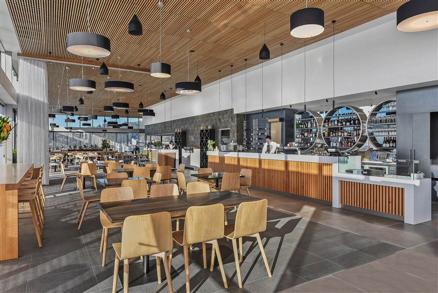
Announcing the HCF 2022 Translational Research Grants!

The HCF Research Foundation Translational Research Grants (TRG) scheme is focused on responding to health issues identified within health care provider communities, and the translation of research findings into practice by health service delivery stakeholders. Through this scheme, the Foundation aims to facilitate the implementation of cost effective, evidencebased innovation into health care delivery to improve outcomes for patients and the work experience of clinical staff.
The 2022 TRG round is calling for applications specifically addressing the topic of “providing appropriate care for the elderly in the community”. This topic aims to facilitate implantation of care models for the elderly that are delivered in the community and includes (but is not limited to) health issues such as frailty,
polypharmacy, palliative care, rehabilitation, end-of-life and advanced care planning, residential aged care and primary care engagement.
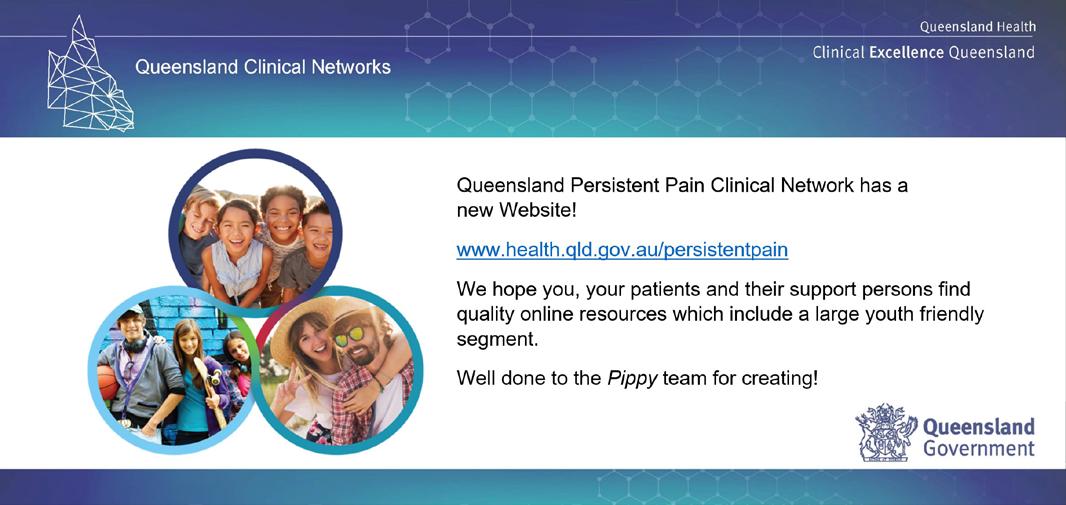
The TRG scheme has a two-stage application process. The first stage requires applicants to submit an expression of interest (EOI), with the second stage being a full application. Expressions of interest will need to be submitted by 14 October 2022 by 5pm AEDT by email to hcffoundation@hcf. com.au
Please visit HCF Foundation Applications https://www.hcf.com.au/about-us/hcffoundation/hcf-foundation-applications to download the application guidelines and EOI form.
BPR Pain Hour:
Evidence-based practice and the contribution of preclinical research in managing dental and craniofacial pain
12-1pm AEDT, Wednesday 19 October 2022 (via Zoom)
The purpose of our Basic Pain Research Special Interest Group (BPR SIG) is to share, improve and promote scientific knowledge and understanding of the mechanisms of nociception and pain across all levels of investigation, from molecular and cellular analyses to pre-clinical or clinical studies.

This forum will provide an informal platform to promote and share our research and insights, from ECRs (including students) and senior colleagues.
Session 5: Evidence-based practice and the contribution of preclinical research in managing dental and craniofacial pain.
Summary:
This session will consider how preclinical research evidence can inform practice. This BPR Pain Hour brings together both a well-known and senior scientist, and an early career clinical researcher, with significant interest in evidence-based practice. Professor Barry Sessle has
published widely in the field of animal and human basic science pain research and will provide an overview of how this has informed the diagnosis and management of dental and craniofacial pain conditions. Dr Erica Martin is a practicing dentist and has recently completed her higher research degree examining the use of the local anaesthetic Articaine. Her particular focus in dentistry has been on safety, efficacy, practitioner perception and evidence-based practice. This seminar will highlight the importance of BPR to inform best clinical practice in the field of dental and craniofacial pain.
The invited speakers:
• Prof Barry Sessle, Faculty of Dentistry, University of Toronto, ON, Canada
• Dr Erica Martin, College of Medicine and Dentistry, James Cook University, QLD
All are welcome to attend, including postgraduate students.
We look forward to seeing you there, please register here.
BPR Pain Hour: Transcriptomic and physiological characterization of human sensory neurons that transduce pain and itch

12-1pm AEDT, Wednesday 23 November 2022 (via Zoom)
The purpose of our Basic Pain Research Special Interest Group (BPR SIG) is to share, improve, and promote scientific knowledge and understanding of the mechanisms of nociception and pain across all levels of investigation, from molecular and cellular analyses to preclinical or clinical studies.
This forum will provide an informal platform to promote and share our research and insights, from ECRs (including students) and senior colleagues.
Session 6: Transcriptomic and physiological characterization of human sensory neurons that transduce pain and itch
Summary:
This session will explore the diversity of human primary sensory neurons of the dorsal root ganglia with a nod to comparing human and rodent models and will include presentations from A/ Prof Steve Davidson from Cincinnati and Dr Lipin Loo in Sydney. The focus of A/ Prof Davidsons talk will be on neuronal subtypes that likely encode pain and itch. Following this will be an overview of human sensory neuron physiology with a focus on sensitization and inhibition of activity by G-protein coupled receptor. Dr Loo will speak about his research which focuses on profiling Cellular and Molecular
Mechanisms of Neuropathic Pain with Integrated Transcriptomics.
The invited speakers:
• Steve Davidson, PhD is an Associate Professor of Anesthesiology at the University of Cincinnati College of Medicine. He began investigating pain and itch over 15 years ago using electrophysiology in the monkey brain and spinal cord and then developed approaches to recover and investigate live human dorsal root ganglia from human organ donors. The Davidson lab also has an interest in thalamo-cortical circuits that process pain and itch.
• Dr Lipin Loo joined the University of Sydney as a Dr John and Anne Chong Genome Editing and Stem Cell Research Fellow and his primary interest is studying the complex process of neuronal differentiation. Lipin received his PhD in Pharmacology from University of Iowa in 2013. He received postdoctoral training in the Zylka lab at the Neuroscience Center of University of North Carolina from 2014 to 2017.
All are welcome to attend, including postgraduate students.
We look forward to seeing you there, please register here.
Pain in Residential Aged Care Facilities: Management Strategies
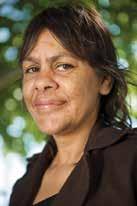
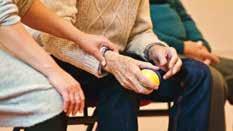
2nd Edition
The gold standard in Pain Management for Older People is now available in eBook format!

In this edition:
Chapter 1: About Pain
Chapter 2: Identi cation and assessment of pain in aged care residents

Chapter 3: Beyond medication: psychological and educational approaches to pain management
Chapter 4: Movement and physical activity
Chapter 5: Complementary approaches to pain
Chapter 6: Pharmacological treatments
Chapter 7: Dementia and cognitive impairment: special considerations

Chapter 8: Pain at the end of life
Chapter 9: Pain and nutrition
Chapter 10: Quality and systems issues
2022 Global Year “Translating Pain Knowledge to Practice”
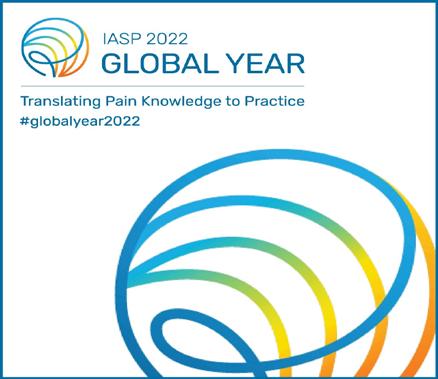 By Dr Aidan Cashin, who is an exercise physiologist and a NHMRC Emerging Leadership Fellow at the Centre for Pain IMPACT Neuroscience Research Australia.
By Dr Aidan Cashin, who is an exercise physiologist and a NHMRC Emerging Leadership Fellow at the Centre for Pain IMPACT Neuroscience Research Australia.

Sharing the knowledge gained through pain research – spanning the spectrum of investigations from molecules to the patients – with researchers, clinicians, healthcare professionals, and patients worldwide is not a simple task. Bridging the gap between pre-clinical studies, human research, clinical trials, and clinical practice is equally challenging. The 2022 Global Year for “Translating Pain Knowledge to Practice” aims to identify and communicate these challenges, with the aim to find solutions for them, and for a better communication between researchers, healthcare professionals, stakeholders, and patients.
Some of these translational challenges can be addressed through partnering with people with lived experience of pain across the knowledge translation spectrum – including in research, education, practice, and policymaking. It is critical that the knowledge gained from pain research is informed and co-produced by the people for whom it is meant to help. People with lived experience bring more than just their pain experiences to these projects, they also bring their lifetime of education, work, and life experiences, as well as their unique talents, skills, and creativity. Partnering with people with lived experience helps improve the quality and relevance of research, the quality and delivery of health care services for people living with pain, and patient and public health outcomes, all of which lead to more meaningful and wider-reaching research impacts.
The process of partnering with people with lived experience in research is descried in a variety of ways, for example, co-creation, co-production, and co-design. There is a now rich and growing practice of involving people with lived experience in research and increasing recognition of its importance by research funders who are beginning to require meaningful patient engagement in funding applications. Partnering with people with lived experience is being advocated globally, and across all health and research sectors. However, there remains uncertainty on what partnership entails, how to do it, when and when not to do it.
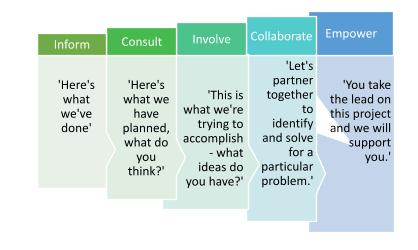
People with lived experience can be involved in all aspects of the research process, including setting research priorities; establishing research agendas; applying for funding; developing research questions; designing and overseeing research studies; recruiting participants; collecting, analysing, and interpreting data; and co-authoring and publishing peer-reviewed papers. People with lived experience can also help share and mobilize the knowledge about pain that we have gained through pain research, for example through co-producing public information campaigns, writing plain language summaries of current and existing research, or sharing knowledge through various blogs and social media communications.
People with lived experience of pain can be involved in all types of research, from pre-clinical studies, human research, clinical trials, all the way to clinical implementation. The International Association for Public Participation has identified five different levels of research engagement for people with lived experience (inform, consult, involve, collaborate, and empower), with each level along the continuum reflecting greater engagement (Figure).
Figure. Adapted from IAP2 Spectrum of Public Participation
To learn more, check out the partnering with people with lived experience in pain research IASP fact sheet. This is one of many fact sheets related to the challenges addressed in this year’s Global Year topic developed by IASP which are freely available for everyone on the IASP website, and through our APS website.
Declaration
Dr Aidan Cashin has nothing to declare.
13-17 November 2022
Novotel Barossa Valley, South Australia

Applications Open: 17 May 2022
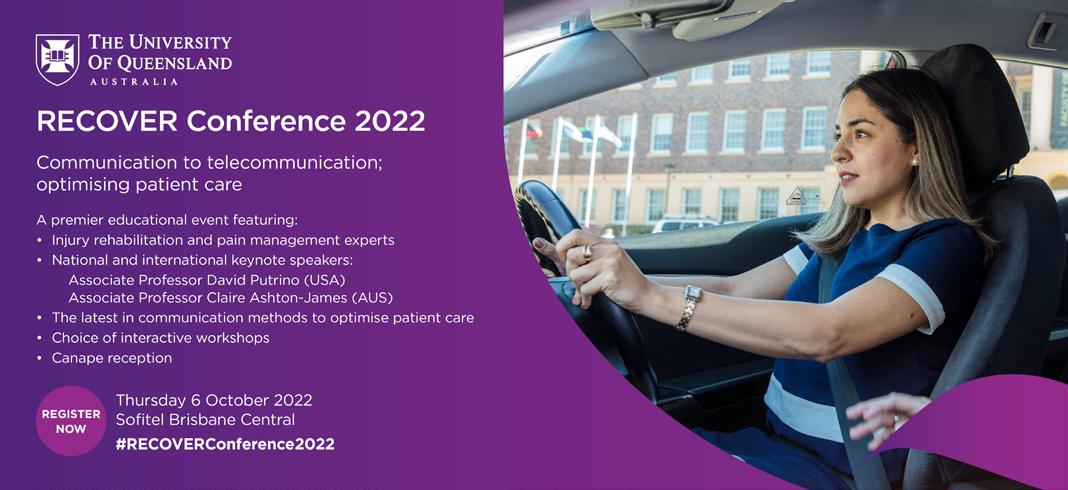
www.dcconferences.com.au/painstar2022
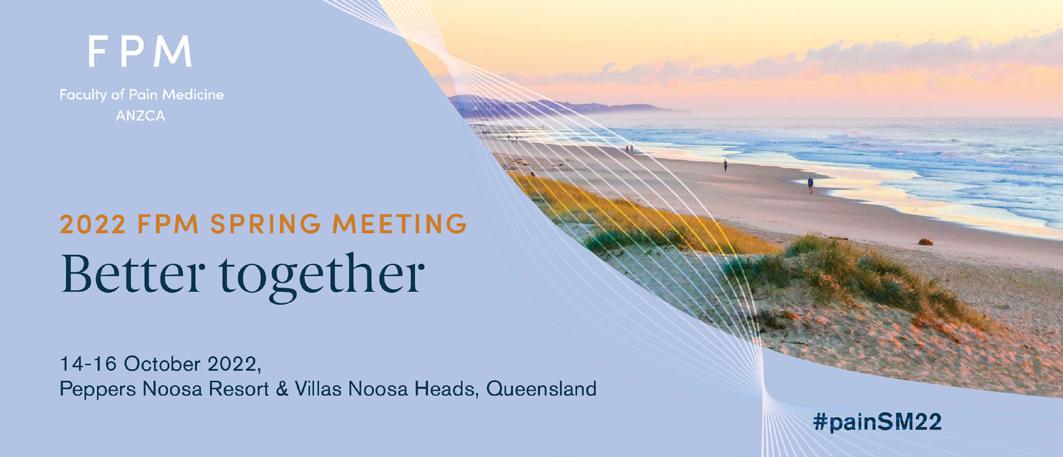
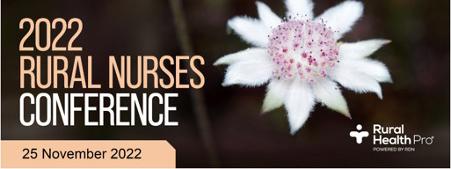







NEW!
> Prof Michael Nicholas, John D Loeser Award Winner, interview on IASP TV on 22SEP22, part of the 2022 World Congress suite of 21 videos: https://www.youtube.com/watch?v=e muWsBbd1_g&list=PL9CZabk3nD4HUXc42SKi Wxv8-FhyXwPgR&index=16
Other items of interest for our members:
> Latest opioid data from the Australian Bureau of Statistics: Opioid induced deaths in Australia. https://www.abs.gov.au/ articles/opioid-induced-deaths-australia
> Australia’s annual overdose report 2019 from the Pennington institute : http:// www.penington.org.au/australias-annualoverdose-report-2019/
> The Third Australian Atlas of Healthcare Variation: This series explores how healthcare use in Australia varies depending on where people live. It investigates reasons for variation that may be unwarranted, and provides specific achievable actions to reduce unwarranted variation. https://www.safetyandquality.gov.au/atlas
> Painaustralia eNewsletter latest issue, available online at http://www.painaustralia. org.au/media/enews
> ePPOC: electronic Persistent Pain Outcomes Collaboration: The electronic Persistent Pain Outcomes Collaboration (ePPOC) is an Australasian initiative that aims to improve the quality of care and outcomes for people who experience chronic pain. For more information about ePPOC, refer to the website: http://ahsri. uow.edu.au/eppoc/index.html
> PainHEALTH website: painHEALTH‘s aim is to help health consumers with musculoskeletal pain access reliable, evidence-based information and tips to assist
in the co-management of musculoskeletal pain. painHEALTH is an initiative of the Department of Health, Western Australia. http://painhealth.csse.uwa.edu.au/
> Stanford University: CHOIR Collaborative Health Outcomes Information Registry https://choir.stanford.edu/
> Opioid Podcasts for GPs: These podcasts are produced by David Outridge GP, and FAChAM Trainee as a project under the auspices of Dr Steven Kelly Staff Specialist in Addiction Medicine, Kullaroo Clinic Gosford. A 20 week series from the Hunter Postgraduate Medical Institute (University of Newcastle) : http://www.gptraining.com.au/ recent-podcasts
> Airing Pain: Pain resources via an online radio show produced by Pain Concern, a UK registered Charity: http://painconcern.org.uk/ airing-pain/
> Digital Health Guide: Developed by Primary Health Network Tasmania, check out the pain resources by accessing the link https:// digitalhealthguide.com.au/Account/LogOn? ReturnUrl=%2fSpecialtyFormulary%2f2 At login, Username: connectingcare, Password: health
> Indigenous Resources: New webpage on the APS website aggregating Indigenous resources: https://www.apsoc.org.au/ Indigenous-Resources
NPS MedicineWise resources:
> Choosing Wisely Australia – News & media: https://www.choosingwisely.org.au/ news-events/media-releases/choosingwisely-resource-addresses-patient-opioidknowledge-gap
> Over the counter codeine – changes to supply: https://www.nps.org.au/medical-info/ clinical-topics/over-the-counter-codeinechanges-to-supply
> Medicines with codeine – what you need to know: https://www.nps.org.au/medical-info/ consumer-info/medicines-with-codeinewhat-you-need-to-know
> Information about opioids and chronic noncancer pain: U-tube clip (5.39mins) https:// www.youtube.com/watch?v=8R4RT0pUCf 4&feature=share&fbclid=IwAR2dbhzgEAcc 7B-ogq2a6Xhud5FDkbciPbdJ9pb94GnQI6p AeifGd1VP-_I
> Opioids: Communications videos: https:// www.nps.org.au/opioids-communication-videos
TGA
> Codeine information hub: https://www.tga. gov.au/news/news/codeine-information-hub
BLOG WEB
NSW Agency for Clinical Innovation resources:
> Brainman and Pain Tool Kit translations, SEP15: http://www.aci.health.nsw.gov.au/
chronic-pain/translated-resources
> Pain Management Resources: https:// aci.health.nsw.gov.au/networks/painmanagement/resources
> Quicksteps to Manage Chronic Pain in Primary Care: http://www.aci.health.nsw. gov.au/chronic-pain/health-professionals/ quick-steps-to-manage-chronic-pain-inprimary-care
> Built into Quicksteps: “How to de-prescribe and wean opioids in general practice”: http:// www.aci.health.nsw.gov.au/chronic-pain/healthprofessionals/quick-steps-to-manage-chronicpain-in-primary-care/how_to_de-prescribe_and_ wean_opioids_in_general_practice
> A list of helpful apps for consumers and clinicians now available at: http://www.aci. health.nsw.gov.au/chronic-pain/healthprofessionals/management-of-chronic-pain
> Chronic Pain in the ED: https://www.aci. health.nsw.gov.au/networks/eci/clinical/ clinical-resources/clinical-tools/pain-
New Members
New Members as at 27 September 2022:
Dr Mitchell Kitchin Gordon General Practice
Mrs Narelle Jenkins Nursing
Mrs Meredith Smith
Physiotherapy
Mrs Zoe Gillott Nursing
Calendar of Events
6 October 2022
RECOVER Conference 2022
Optimising patient care: from interpersonal to digital connections
Sofitel Brisbane Central, Brisbane, QLD https://recover.centre.uq.edu.au/
14-16 October 2022
Faculty of Pain Medicine (FPM)
2022 FPM Spring Meeting
Peppers Noosa Resort & Villas, Noosa, QLD https://www.anzca.edu.au/events-courses/ events/major-events/fpm-national-events/2022fpm-spring-meeting
21-24 October 2022
NZSA & ASA Combined Scientific Congress 2022
Jointly hosted by the New Zealand Society of Anaesthetists (NZSA) and the Australian Society of Anaesthetists (ASA)
TSB Arena, Wellington, NZ
https://www.csc2022.co.nz/
26-27 October 2022
Australia & New Zealand Musculoskeletal Clinical Trials Network
ANZMUSC October 2022 Scientific Meeting
School of Public Health & Preventative Medicine, Monash University, Melbourne, VIC https://shop.monash.edu/anzmusc-october2022-scientific-meeting-registration.html
13-17 November 2022
Australian Pain Society
painSTAR - Pain School for Translation And Research
Novotel Barossa Valley, Adelaide Hills, SA https://dcconferences.eventsair.com/painstar
15-16 November 2022
National Rural & Remote Allied Health SARRAH Conference 2022
People, Purpose, Passion: Pathways to Success
Virtual, Online Conference
https://sarrahconference.com.au/
25-27 November 2022
Royal Australian College of General Practitioners (RACGP)
GP22
Melbourne Convention & Exhibition Centre, Melbourne, VIC
https://www.racgp.org.au/gp22/gp22-home
25 November 2022
Rural Health Pro
2022 Rural Nurses Conference
Crowne Plaza Sydney Coogee Beach, Sydney, NSW
https://web.cvent.com/event/5fdc11ff-97b7-48c7b992-4147d22cceff/summary
23-26 March 2023
New Zealand Pain Society
NZPS 2023 “Designing a Better Future”
The Cordis Hotel, Auckland, NZ
https://www.nzps2023.nz/
2-5 April 2023
Australian Pain Society
APS 2023 43rd Annual Scientific Meeting
National Convention Centre, Canberra, ACT
https://www.dcconferences.com.au/aps2023/
6-7 May 2023
Exercise & Sports Science Australia (ESSA)
2023 ESSA - Innovation & Practice Forum
Novotel Sunshine Coast Resort, Sunshine Coast Twin Waters, QLD
https://www.essaforum.com.au/
10-13 September 2023
Rehabilitation Medicine Society of Australia & New Zealand
RMSANZ2023 6th Annual Scientific MeetingDiversity and Leadership
Hotel Grand Chancellor, Hobart, TAS
https://www.dcconferences.com.au/rmsanz2023/ home
20-23 September 2023
European Pain Federation EFIC 13th Congress
Personalised Pain Management: The future is now Budapest, Hungary
https://europeanpainfederation.eu/efic2023/
Vision, Purpose & Priorities
Vision:
All people will have optimal pain management throughout life.
Purpose:
The Australian Pain Society is a multidisciplinary association whose purpose is to advance pain management through education, research, and advocacy for transformational improvements in clinical care.
Priorities:
In order to achieve our purpose, the Australian Pain Society will provide:
> Membership
> Research
> Education
> Services and resources
> Good governance and operations
> Advocacy
Directors
President:
Ms Trudy Maunsell
Acute Pain Service
Princess Alexandra Hospital
Woolloongabba QLD 4102
Tel: 07 3176 5547 Fax: 07 3176 5102
President-Elect:
Mrs Joyce McSwan
Gold Coast Primary Health Network
Persistent Pain Program, QLD and PainWISE

Tel: 0412 327 795 Fax: 07 3539 9801
Secretary:
Mrs Dinah Spratt
Physiotas Physiotherapy
Shearwater TAS 7307
Tel: 03 6428 7500 Fax: 03 6424 7811
Treasurer

Dr Laura Prendergast





Pain Service, Northern Health
Broadmeadows VIC 3047
Tel: TBA Fax: N/A
ACT Director:
Dr Andrew Watson

Calvary Hospital
Canberra ACT 2617
Tel: 02 6201 6352 Fax: N/A
NSW Director:
Dr Tim Ho

Inner West Pain Centre
RPA Medical Centre
Newtown NSW 2042
Tel: 02 9517 1764 Fax: 02 9517 1832
NT Director:
TBA
Currently vacant, please contact the APS Secretariat with your expression of interest - aps@apsoc.org.au
QLD Director:
Mrs Karalyn Huxhagen
KH Pharmacy Consulting
Mackay QLD 4740
Tel: 0418 185 972 Fax: 07 4805 6155
SA Director:
Dr Michelle Harris


Royal Adelaide Hospital and Lyell McEwin Hospital
Adelaide SA
Email: michelle.harris2@sa.gov.au
TAS Director:
Ms Bernadette Smith
Psychology Plus
South Burnie TAS
Tel: 03 6431 9959 Fax: 03 6431 9950
VIC Director:
Dr Esther Dube

Austin Health Heidelberg VIC 3084
Tel: New VIC members please contact
Dinah Spratt – Secretary Fax: N/A
WA Director:
Ms Jacintha Bell
Lifeworks Occupational Therapy
Subiaco WA 6008
Tel: 0451 178 880 Fax: 08 6323 3329
Office Bearers
Immediate Past President:
A/Prof Anne Burke
Central Adelaide Local Health Network
Royal Adelaide Hospital
Adelaide SA 5000
Tel: 08 7074 2835 Fax: 08 7074 6247
SPC Chair:
Professor Kevin Keay



Department of Anatomy
University of Sydney
Sydney NSW 2006
Tel: 02 9351 4132 Fax: 02 9351 2817
IASP Liaison:
Professor Michele Sterling

Recovery Injury Research Centre
University of Queensland
Herston QLD 4092
Tel: 07 3346 4793
Communications Coordinator:
Ms Trudy Maunsell
Acute Pain Service
Princess Alexandra Hospital
Woolloongabba QLD 4102
Tel: 07 3176 5547 Fax: 07 3176 5102
Newsletter Editor:
Dr Lincoln Tracy
School of Public Health and Preventive Medicine
Monash University
Melbourne VIC 3004
Tel: 03 9903 0288
Newsletter Assistant Editor:
Dr Joanne Harmon



School of Clinical and Health Sciences
University of South Australia
Adelaide SA 5000
Tel: 08 8302 1442
Scholarship/Grant Selection
Subcommittee Chair:
Dr Michael Farrell
Retired
VIC Secretariat:
DC Conference & Association
Management Pty Ltd
PO Box 637
North Sydney, NSW 2059
Tel: 02 9016 4343
Email: aps@apsoc.org.au
Website: apsoc.org.au
